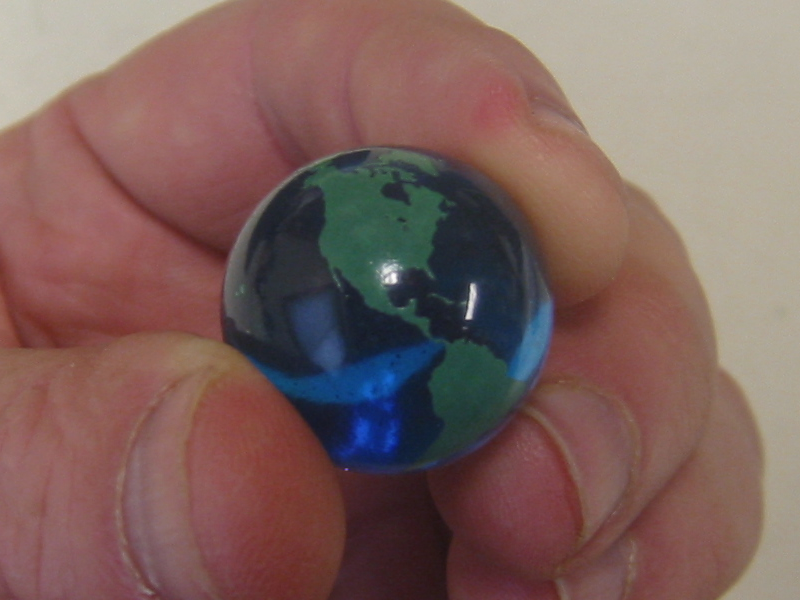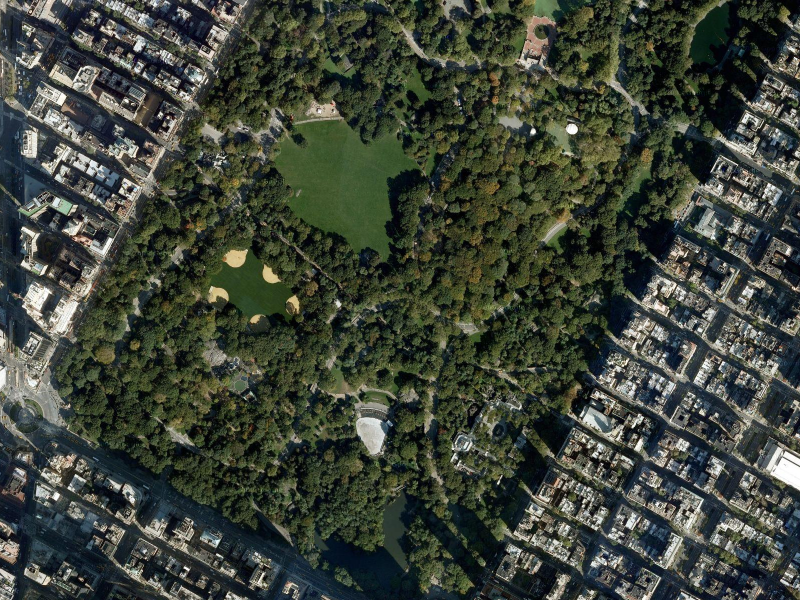212 acres and a marble
Here is a little blue marble, painted with little green continents. The green continents, and transparent ocean, represent the distribution of life on earth. Though life started in the oceans, life is relatively sparse in them, occuring mostly around nutrient upwellings. The rest of the ocean is almost lifeless. The land has much higher biomass per square meter, even in regions like the Mojave desert. So, besides the ice caps and mineral deserts like parts of the Sahara, the land represents plant life, and the food chain that depends on it. The marble is pretty accurate as a representation of life. |
The marble is 2.20 centimeters (0.866 inches) in diameter, about 166 pixels across on the webpage. The earth is 12,740 kilometers in diameter, 580 million times bigger than the marble, so each pixel in the photo above is about 75km on a side. The earth intercepts 174,000 TW (terawatts) of energy from the sun. 70,000 TW makes it to the surface. About 20,000 TW of that energy is captured by land plants, from rain forests to the soil microbes of the Mojave. Most of that captured energy drives chemical processes in the cells of the plants. About 200 TW remains to become food and fiber, which feeds animals and microbes and fungi. While the fraction used by animals and fungi is small, these organisms are the recyclers of nature, converting dead plants into the materials to make more plants. Interrupting those flows damages the biosphere.
A healthy adult consumes 2000 Calories a day, which is about 100 watts. That is about half a terawatt for all the humans alive today. We consume about 14 TW of manufactured energy globally. A sustainable world of 10 billion humans, living at first-world standards, might consume 100 TW of manufactured energy by the end of the century. Obviously we are not going to get that by burning 200 TW of plant product, and robbing the other animals and fungi. We are not going to get 100 TW by wind and solar, because without gigantic year-capacity energy storage devices, we must displace huge amounts of habitat to have enough production capacity for winter. Our bite of the biosphere is already too large. What to do?
In space, energy is not interrupted by clouds, or winter, or night. One square kilometer of sunlight is 1.36 billion watts. Solar cells in space, with 15% efficency and 70% availability, can deliver 140 million watts per square kilometer. A 200nm thick, graded junction InP solar cell is highly radiation resistant, and weighs 1 gram per square meter, ten tons per square kilometer with a 10x thicker substrate. At $10,000/kg launch cost, that is 70 cents per watt - and launch can be orders of magnitude cheaper.
One pixel in the picture above, 75 by 75 kilometers, is 800 billion watts, 0.8 TW. Florida is 170,000 square kilometers, and that area could produce 24 TW in space. The highlight in the middle of the marble represents more than 100 TW. Because of clouds, and night, and winter, the amount of area needed for ground solar would be far larger.
The sun puts out 384 trillion terawatts. How much is that compared to the earth? 2.26 billion times the energy shining on the whole earth. The rest of the sunlight blows out into empty space, never to interact with matter again. A tiny fraction may be visible as starlight on other worlds, but beyond 60 light years, the sun would only be visible with a telescope. It is very unlikely that the light of the sun matters to anyone or anything besides life in the solar system.
The cross section of the marble is 3.8 cm2 ( 0.588 in2 ). 2.26 billion times that is 86 hectares (212 acres), a square 920 meters on a side, or a circle 1050 meters in diameter.
86 hectares is the area of the lower part of New York's Central Park, below 72nd street. The squiggly street near the top of this photo connects to 72nd street. |
Imagine a person standing in the middle of the big field - on the scale shown, the person would be about a tenth of one pixel. The person is holding up a marble. Imagine that the marble holds on its surface all the life we know about, perhaps all the life there is. The entire park is available as a future home for digital and biological life.
With all that area waiting for us, available but unused, how can we possibly think of stealing habitat from life on that tiny little marble?
There are 100 billion stars in our galaxy. Someday, we will reach all of them. The ratio of their energy output, to that of our sun, is the same as the ratio of 170 Earth surfaces to lower Central Park. That is our legacy. Perhaps we share that legacy with other life elsewhere. That makes it even more important to learn to share our tiny little marble with all of life, in preparation for the sharing we will do in the far future.
The universe is vast, and almost completely lifeless. Our mission, perhaps allied with other spacefaring species, is to bring life to all of it.

